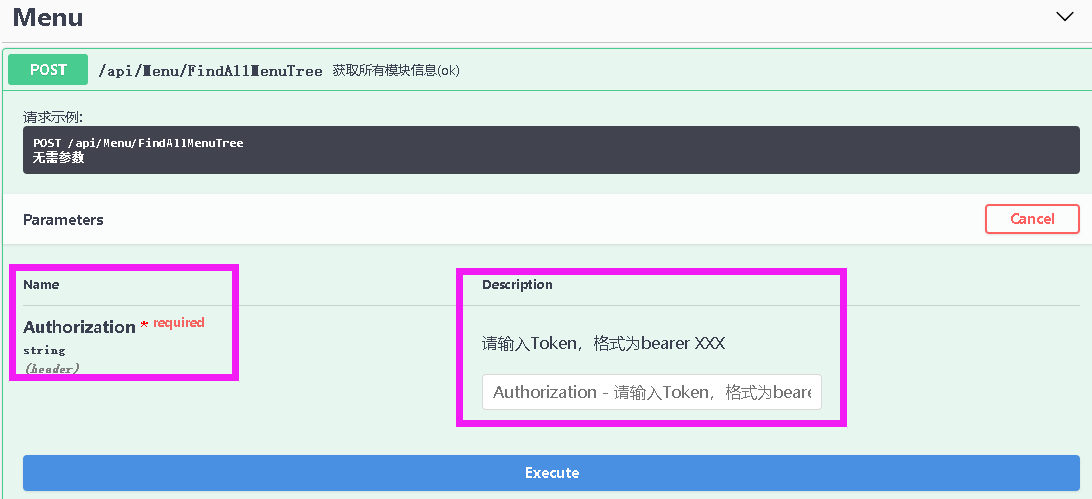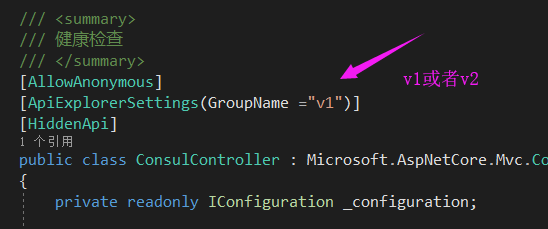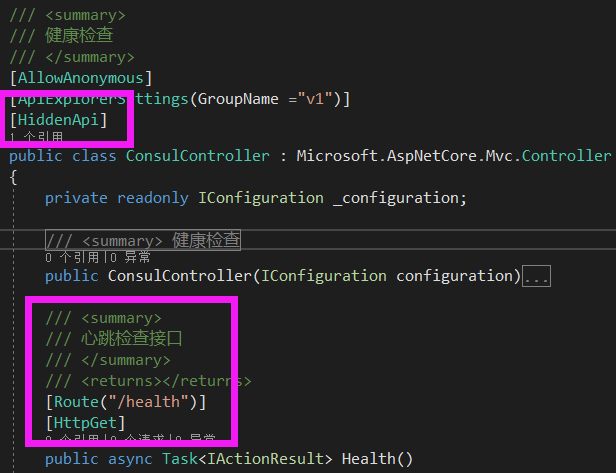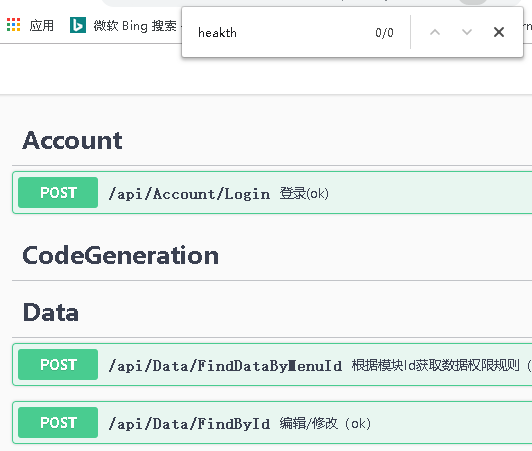您好,登錄后才能下訂單哦!
您好,登錄后才能下訂單哦!
這篇文章給大家分享的是有關Asp.Net Core WebAPI如何使用Swagger時API隱藏和分組的內容。小編覺得挺實用的,因此分享給大家做個參考,一起跟隨小編過來看看吧。
1、前言
為什么我們要隱藏部分接口?
因為我們在用swagger代替接口的時候,難免有些接口會直觀的暴露出來,比如我們結合Consul一起使用的時候,會將健康檢查接口以及報警通知接口暴露出來,這些接口有時候會出于方便考慮,沒有進行加密,這個時候我們就需要把接口隱藏起來,只有內部的開發者知道。
為什么要分組?
通常當我們寫前后端分離的項目的時候,難免會遇到編寫很多接口供前端頁面進行調用,當接口達到幾百個的時候就需要區分哪些是框架接口,哪些是業務接口,這時候給swaggerUI的接口分組是個不錯的選擇。

swagger的基本使用這里將不再贅述,可以閱讀微軟官方文檔,即可基本使用
2、swaggerUI中加入授權請求
新建HttpHeaderOperationFilter操作過濾器,繼承Swashbuckle.AspNetCore.SwaggerGen.IOperationFilter接口,實現Apply方法
/// <summary>
/// swagger請求頭
/// </summary>
public class HttpHeaderOperationFilter : IOperationFilter
{
public void Apply(Operation operation, OperationFilterContext context)
{
#region 新方法
if (operation.Parameters == null)
{
operation.Parameters = new List<IParameter>();
}
if (context.ApiDescription.TryGetMethodInfo(out MethodInfo methodInfo))
{
if (!methodInfo.CustomAttributes.Any(t => t.AttributeType == typeof(AllowAnonymousAttribute))
&&!(methodInfo.ReflectedType.CustomAttributes.Any(t => t.AttributeType == typeof(AuthorizeAttribute))))
{
operation.Parameters.Add(new NonBodyParameter
{
Name = "Authorization",
In = "header",
Type = "string",
Required = true,
Description = "請輸入Token,格式為bearer XXX"
});
}
}
#endregion
#region 已過時
//if (operation.Parameters == null)
//{
// operation.Parameters = new List<IParameter>();
//}
//var actionAttrs = context.ApiDescription.ActionAttributes().ToList();
//var isAuthorized = actionAttrs.Any(a => a.GetType() == typeof(AuthorizeAttribute));
//if (isAuthorized == false)
//{
// var controllerAttrs = context.ApiDescription.ControllerAttributes();
// isAuthorized = controllerAttrs.Any(a => a.GetType() == typeof(AuthorizeAttribute));
//}
//var isAllowAnonymous = actionAttrs.Any(a => a.GetType() == typeof(AllowAnonymousAttribute));
//if (isAuthorized && isAllowAnonymous == false)
//{
// operation.Parameters.Add(new NonBodyParameter
// {
// Name = "Authorization",
// In = "header",
// Type = "string",
// Required = true,
// Description = "請輸入Token,格式為bearer XXX"
// });
//}
#endregion
}
}然后修改Startup.cs中的ConfigureServices方法,添加我們自定義的HttpHeaderOperationFilter過濾器
public IServiceProvider ConfigureServices(IServiceCollection services)
{
...
services.AddSwaggerGen(c =>
{
...
c.OperationFilter<HttpHeaderOperationFilter>();
});
...
}這時候我們再訪問swaggerUI就可以輸入Token了

3、API分組
修改Startup.cs中的ConfigureServices方法,添加多個swagger文檔
public IServiceProvider ConfigureServices(IServiceCollection services)
{
...
services.AddSwaggerGen(c =>
{
c.SwaggerDoc("v1", new Info
{
Version = "v1",
Title = "接口文檔",
Description = "接口文檔-基礎",
TermsOfService = "",
Contact = new Contact
{
Name = "XXX1111",
Email = "XXX1111@qq.com",
Url = ""
}
});
c.SwaggerDoc("v2", new Info
{
Version = "v2",
Title = "接口文檔",
Description = "接口文檔-基礎",
TermsOfService = "",
Contact = new Contact
{
Name = "XXX2222",
Email = "XXX2222@qq.com",
Url = ""
}
});
//反射注入全部程序集說明
GetAllAssemblies().Where(t => t.CodeBase.EndsWith("Controller.dll")).ToList().ForEach(assembly =>
{
c.IncludeXmlComments(assembly.CodeBase.Replace(".dll", ".xml"));
});
c.OperationFilter<HttpHeaderOperationFilter>();
//c.DocumentFilter<HiddenApiFilter>();
});
...
}修改Startup.cs中的Configure方法,加入
public void Configure(IApplicationBuilder app, ILoggerFactory loggerFactory)
{
...
app.UseSwagger();
app.UseSwaggerUI(c =>
{
c.SwaggerEndpoint("/swagger/v2/swagger.json", "接口文檔-基礎");//業務接口文檔首先顯示
c.SwaggerEndpoint("/swagger/v1/swagger.json", "接口文檔-業務");//基礎接口文檔放后面后顯示
c.RoutePrefix = string.Empty;//設置后直接輸入IP就可以進入接口文檔
});
...
}然后還要在我們的控制器上面標注swagger文檔的版本

這時候我們就可以將接口文檔進行分組顯示了

4、API隱藏
創建自定義隱藏特性HiddenApiAttribute.cs
/// <summary>
/// 隱藏swagger接口特性標識
/// </summary>
[AttributeUsage(AttributeTargets.Method | AttributeTargets.Class)]
public class HiddenApiAttribute:System.Attribute
{
}創建API隱藏過濾器HiddenApiFilter繼承Swashbuckle.AspNetCore.SwaggerGen.IDocumentFilter接口,實現Apply方法
/// <summary>
/// 自定義Swagger隱藏過濾器
/// </summary>
public class HiddenApiFilter : IDocumentFilter
{
public void Apply(SwaggerDocument swaggerDoc, DocumentFilterContext context)
{
foreach (ApiDescription apiDescription in context.ApiDescriptions)
{
if (apiDescription.TryGetMethodInfo(out MethodInfo method))
{
if (method.ReflectedType.CustomAttributes.Any(t=>t.AttributeType==typeof(HiddenApiAttribute))
|| method.CustomAttributes.Any(t => t.AttributeType == typeof(HiddenApiAttribute)))
{
string key = "/" + apiDescription.RelativePath;
if (key.Contains("?"))
{
int idx = key.IndexOf("?", System.StringComparison.Ordinal);
key = key.Substring(0, idx);
}
swaggerDoc.Paths.Remove(key);
}
}
}
}
}在Startup.cs中使用HiddenApiFilter
public IServiceProvider ConfigureServices(IServiceCollection services)
{
...
services.AddSwaggerGen(c =>
{
c.SwaggerDoc("v1", new Info
{
Version = "v1",
Title = "接口文檔",
Description = "接口文檔-基礎",
TermsOfService = "",
Contact = new Contact
{
Name = "XXX1111",
Email = "XXX1111@qq.com",
Url = ""
}
});
c.SwaggerDoc("v2", new Info
{
Version = "v2",
Title = "接口文檔",
Description = "接口文檔-基礎",
TermsOfService = "",
Contact = new Contact
{
Name = "XXX2222",
Email = "XXX2222@qq.com",
Url = ""
}
});
//反射注入全部程序集說明
GetAllAssemblies().Where(t => t.CodeBase.EndsWith("Controller.dll")
&& !t.CodeBase.Contains("Common.Controller.dll")).ToList().ForEach(assembly =>
{
c.IncludeXmlComments(assembly.CodeBase.Replace(".dll", ".xml"));
});
c.OperationFilter<HttpHeaderOperationFilter>();
c.DocumentFilter<HiddenApiFilter>();
});
...
}示例:
我這里提供了Consul的心跳檢車接口

但是在接口文檔中并沒有顯示出來

感謝各位的閱讀!關于“Asp.Net Core WebAPI如何使用Swagger時API隱藏和分組”這篇文章就分享到這里了,希望以上內容可以對大家有一定的幫助,讓大家可以學到更多知識,如果覺得文章不錯,可以把它分享出去讓更多的人看到吧!
免責聲明:本站發布的內容(圖片、視頻和文字)以原創、轉載和分享為主,文章觀點不代表本網站立場,如果涉及侵權請聯系站長郵箱:is@yisu.com進行舉報,并提供相關證據,一經查實,將立刻刪除涉嫌侵權內容。